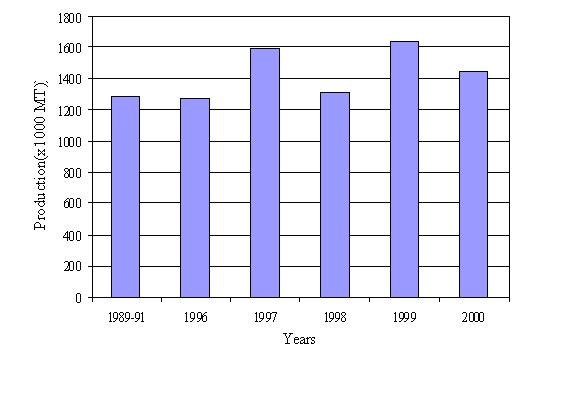Almond is one of the major and oldest tree nut crops in the world (Fig. 2). It belongs to genus Prunus, subgenus Amygdalus, family Rosaceae. The almond originated in the hot and dry climate of the Middle East, more specifically Iran, and was subsequently spread along the shores of the Mediterranean towards northern Africa and southern Europe by Egyptians, Greeks, and Romans.

According to FAO (2000), annual world production of unshelled almonds is around one million tonnes with a tendency to increase (Fig. 3).

Almond kernel is a very high energy source: 100 g fresh weight results in 142.93 Joules and contains protein (19 g), fat (54 g), carbohydrates (21 g), water (5 g), minerals and vitamins (Mitra et al., 1994). Almond kernels are used in perfume and pharmaceuticals whereas a small amount is used for making pastries. Finally, by-products of almond are used in chemical industry. Back to top
There are various climates and soils in Iran and each climate and soil is capable to fulfil the requirements of a specific number of crops. Arid and semi-arid climates are the most important in Iran as they cover about 70 percent of the country’s surface area. Water deficiency, salinity, and high lime concentration in soils are the most common factors that limit quality and quantity of crop production in arid and semi-arid regions of Iran and also in other countries. These factors also have a determining role in the distribution and diversity of crop plants. Therefore, agricultural activities are concentrated in irrigated areas, which are situated along rivers and near cities. Triticum spp., Hordeum spp. and Medicago sativa are the most important crops are produced in arid and semi-arid regions of Iran. These crops are planted in foothill areas characterised by the presence of fine alluvial soil and occurrence of adequate in quantity and distribution rain and snow. Gossypium spp., Crocus sativus, Beta vulgaris and Saccharum officinarum are industrial crops that are grown in the arid and semi-arid regions of Iran. Pistacia vera and Amygdalus dulcis are the perennial fruit crops of these regions. They have an important role in the economy of the country. Amygdalus scoparia (syn.: Prunus scoparia) and A. lycioides (syn.: Prunus lycioides) are native wild species of Iran (Sabeti, 1975). They occupy large areas in many parts of Iran and are appreciable from several aspects:
Seeds of Amygdalus scoparia and A. lycioides were collected from natural vegetation at Shahrekord Natural Resources Institute in Chaharmahal-Bakhtiari province, Iran. Experimental design was a factorial with complete random as basic design with three replications (each replication has four seeds in one petri-dish). In this study, temperature treatments (7 and 22 °C) were main plots and GA3 (0,125, 250, 500 and 1000 ppm) treatments were subplots.
The seeds were soaked for 4 days in 0, 125, 250, 500 and 1000 ppm solution of GA3.The seeds as a control soaked for 4 days in water. Finally, all treatments were transferred to a refrigerator/incubator and maintained at temperatures of 7/21 °C, respectively.
In all above cases, germination percentages were followed for 2 to 3 months. Data were statistically analysed according to the factorial design by SPSS. Average results were compared by the 'Duncan test'. The objective of the present study is to investigate if GA3 and cold alone, or in combination, could influence germination of Amygdalus scoparia and A. lycioides seeds.